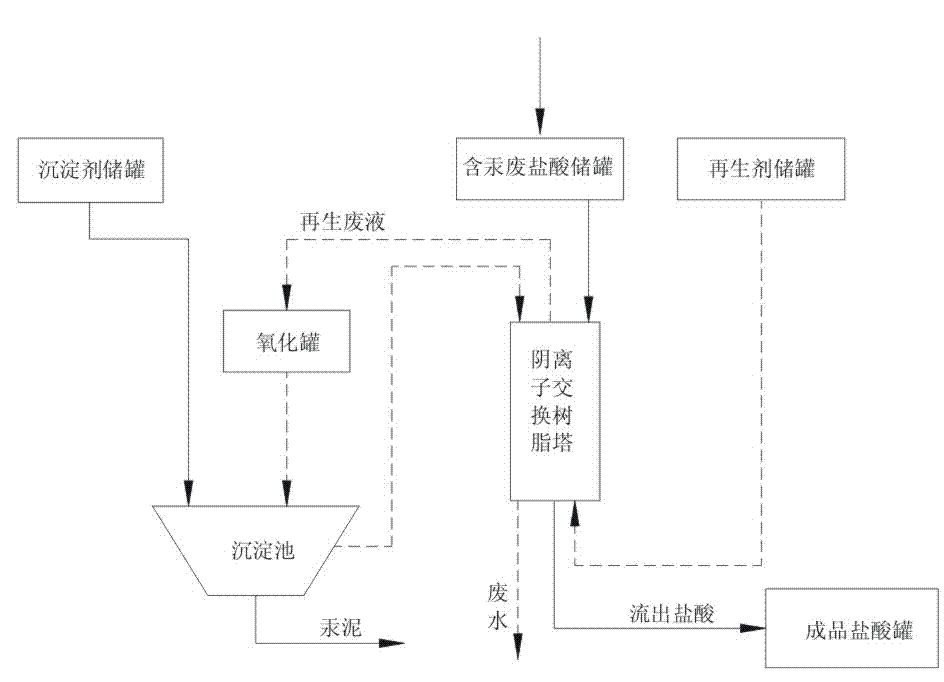Recovery treatment process of mercury-containing waste hydrochloric acid
A technology for recycling and processing waste hydrochloric acid, applied in chlorine/hydrogen chloride purification, chlorine/hydrogen chloride and other directions, can solve the problems of high processing cost, affecting the survival and development of enterprises, poor processing effect, etc., and achieve the effect of avoiding pollution and improving economic benefits.
- Summary
- Abstract
- Description
- Claims
- Application Information
AI Technical Summary
Problems solved by technology
Method used
Image
Examples
Embodiment 1
[0021] The recovery and treatment process of mercury-containing waste hydrochloric acid, such as figure 1 As shown, the steps include:
[0022] 1) Pass the waste hydrochloric acid with a mercury content of 30mg / L into a strong basic anion exchange resin tower (filled with British Purite A600MB strong basic anion exchange resin) for ion exchange, and control the flow rate of mercury-containing waste hydrochloric acid to 10L / min Collect and flow out hydrochloric acid in the finished product hydrochloric acid tank, and the mercury content of sampling analysis flowing out hydrochloric acid is 0.05mg / l.
[0023] 2) When the mercury content of the effluent hydrochloric acid reaches more than 0.1mg / L, regenerate the anion exchange resin: feed the regenerant (10wt% sodium sulfite aqueous solution) from the bottom of the resin tower, and control the flow rate of the regenerant at 5L / min. Regeneration treatment for 30 minutes; collect the regeneration waste liquid flowing out from ...
Embodiment 2
[0025] The recovery and treatment process of mercury-containing waste hydrochloric acid, such as figure 1 As shown, the steps include:
[0026] 1) Pass the waste hydrochloric acid with a mercury content of 20mg / L into a strong basic anion exchange resin tower (filled with British Purite A600MB strong basic anion exchange resin) for ion exchange, and control the flow rate of the mercury-containing waste hydrochloric acid to 50 L / min; collect the effluent hydrochloric acid into the finished product hydrochloric acid tank, take a sample and analyze the mercury content of the effluent hydrochloric acid to be 0.08mg / l.
[0027] 2) When the mercury content of the effluent hydrochloric acid reaches above 0.1mg / L, regenerate the anion exchange resin: feed the regenerant (10wt% sodium sulfite aqueous solution) from the bottom of the resin tower, and control the flow rate of the regenerant at 10 L / min , regenerate for 40 minutes; collect the regenerated waste liquid flowing out fr...
Embodiment 3
[0029] The recovery and treatment process of mercury-containing waste hydrochloric acid, such as figure 1 As shown, the steps include:
[0030] 1) Pass the waste hydrochloric acid with a mercury content of 26 mg / L into a strong basic anion exchange resin tower (filled with British Purite A600MB strong basic anion exchange resin) for ion exchange, and control the flow rate of the mercury-containing waste hydrochloric acid to 100 L / min; collect the effluent hydrochloric acid into the finished product hydrochloric acid tank, take a sample and analyze the mercury content of the effluent hydrochloric acid to be 0.02mg / l.
[0031] 2) When the mercury content of the effluent hydrochloric acid reaches above 0.1mg / L, regenerate the anion exchange resin: feed the regenerant (10wt% potassium sulfite aqueous solution) from the bottom of the resin tower, and control the flow rate of the regenerant at 20 L / min , regeneration treatment for 60 minutes; collect the regeneration waste liq...
PUM
 Login to View More
Login to View More Abstract
Description
Claims
Application Information
 Login to View More
Login to View More - R&D Engineer
- R&D Manager
- IP Professional
- Industry Leading Data Capabilities
- Powerful AI technology
- Patent DNA Extraction
Browse by: Latest US Patents, China's latest patents, Technical Efficacy Thesaurus, Application Domain, Technology Topic, Popular Technical Reports.
© 2024 PatSnap. All rights reserved.Legal|Privacy policy|Modern Slavery Act Transparency Statement|Sitemap|About US| Contact US: help@patsnap.com









